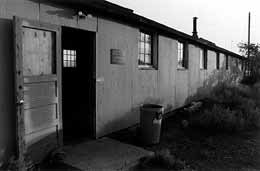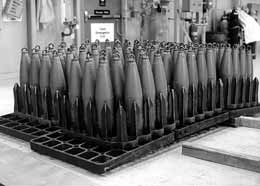
 The
Center for Land Use Interpretation (Finger #1) is a non profit research
organization, which, according to their web site, is dedicated to "the
increase and diffusion of information about how the world's lands are
apportioned, utilized and perceived." Each summer, CLUI sponsors an artist
residency program on an abandoned air force base in Wendover, Utah. The
Wendover Airfield is best known as the training ground for the crew that
dropped atomic bombs on Hiroshima and Nagasaki. The airfield hasn't been
used by the army since 1977 (when it was sold to the town of Wendover
for one dollar), but it has become a popular location for movie productions,
most recently, "Con Air". Decaying evidence of authentic military history
and simulated Hollywood history are visible everywhere on the grounds;
it's often impossible to distinguish between the two. In August 1998,
I spent a month living in the CLUI Wendover barracks. I went there to
make a film about a two man revolutionary group called the American Republican
Army. In a weekend long sabotage spree in May 1961, these self styled
revolutionaries blew up three telephone microwave relay stations in Utah
and Nevada as a protest against "privately owned utility companies and
business cartels such as the American Telephone and Telegraph Company"
(Elko Free Press, June 19, 1961). I didn't know anything about the geography
of the area when I arrived in Utah. It was on the two-hour drive between
the Salt Lake City airport and Wendover that I first became aware of
the extraordinarily disparate land use in this isolated part of the United
States. This 130-mile stretch of Interstate 80 is a dramatic tour of
the natural, industrial and military forces that have shaped the late
twentieth century American landscape. Some highlights include: 1. Bonneville
Salt Flats The
The
Center for Land Use Interpretation (Finger #1) is a non profit research
organization, which, according to their web site, is dedicated to "the
increase and diffusion of information about how the world's lands are
apportioned, utilized and perceived." Each summer, CLUI sponsors an artist
residency program on an abandoned air force base in Wendover, Utah. The
Wendover Airfield is best known as the training ground for the crew that
dropped atomic bombs on Hiroshima and Nagasaki. The airfield hasn't been
used by the army since 1977 (when it was sold to the town of Wendover
for one dollar), but it has become a popular location for movie productions,
most recently, "Con Air". Decaying evidence of authentic military history
and simulated Hollywood history are visible everywhere on the grounds;
it's often impossible to distinguish between the two. In August 1998,
I spent a month living in the CLUI Wendover barracks. I went there to
make a film about a two man revolutionary group called the American Republican
Army. In a weekend long sabotage spree in May 1961, these self styled
revolutionaries blew up three telephone microwave relay stations in Utah
and Nevada as a protest against "privately owned utility companies and
business cartels such as the American Telephone and Telegraph Company"
(Elko Free Press, June 19, 1961). I didn't know anything about the geography
of the area when I arrived in Utah. It was on the two-hour drive between
the Salt Lake City airport and Wendover that I first became aware of
the extraordinarily disparate land use in this isolated part of the United
States. This 130-mile stretch of Interstate 80 is a dramatic tour of
the natural, industrial and military forces that have shaped the late
twentieth century American landscape. Some highlights include: 1. Bonneville
Salt Flats The  Bonneville
Salt Flats are the remnants of prehistoric Lake Bonneville. This shimmering,
salt packed expanse is as hard as the concrete highway that divides it
in two. Every summer for the last fifty years, hot rod racers from around
the world have been making a pilgrimage to this featureless desert terrain
to attempt to break land speed records. However, the salt flats are disappearing:
the salt crust that was seven feet deep in 1960 is now only five feet
deep. The racers blame the erosion on Reiley Industries, a mining company
that harvests potash on the opposite side of the Interstate. This surreal
landscape is also a popular location for television and movies, from
Lexus car commercials to the 1997 film Independence Day. 2. Dugway Proving
Ground Since 1942, this has been the primary test site for the U.S. military's
chemical, biological and incendiary weapons. Napalm was tested for the
first time on this 800,000-acre site. In decades of secret tests, the
Army released over a half million pounds of deadly nerve agents into
the Utah wind. The Army discontinued use of nerve agents in open-air
tests after an experiment went haywire and killed six thousand sheep
downwind in nearby Skull Valley. 3. Tooele Fifty miles away, the history
of The Dugway Proving Ground is being systematically reversed. The Tooele
Chemical Agent Incinerator is the first full scale facility in the United
States built expressly to destroy 14,000 tons of chemical weapons left
over from the Cold War. The nerve agents GB, VX and mustard gas await
incineration in weapons ranging from bombs, mines and mortar rounds to
rockets, spray tanks and artillery projectiles. The city of Tooele has
a population of more than 15,000 and is ten miles north of the plant.
Former employees of the Incinerator have alleged that health, safety
and environmental problems are rampant at the $450 million complex. 4.
MagCorp. For the second year in a row, Magnesium Corporation has earned
the distinction of being the largest industrial air polluter in America,
according to the Environmental Protection Agency's Toxic Releases Inventory.
Each year, MagCorp. releases almost 56 million pounds of toxic chlorine
into the air from its 120-acre processing plant in Rowley, Utah. The
company busses workers to the factory from the nearby town of Grantsville
because the chlorine emissions have been known to peel the paint off
of cars.
Bonneville
Salt Flats are the remnants of prehistoric Lake Bonneville. This shimmering,
salt packed expanse is as hard as the concrete highway that divides it
in two. Every summer for the last fifty years, hot rod racers from around
the world have been making a pilgrimage to this featureless desert terrain
to attempt to break land speed records. However, the salt flats are disappearing:
the salt crust that was seven feet deep in 1960 is now only five feet
deep. The racers blame the erosion on Reiley Industries, a mining company
that harvests potash on the opposite side of the Interstate. This surreal
landscape is also a popular location for television and movies, from
Lexus car commercials to the 1997 film Independence Day. 2. Dugway Proving
Ground Since 1942, this has been the primary test site for the U.S. military's
chemical, biological and incendiary weapons. Napalm was tested for the
first time on this 800,000-acre site. In decades of secret tests, the
Army released over a half million pounds of deadly nerve agents into
the Utah wind. The Army discontinued use of nerve agents in open-air
tests after an experiment went haywire and killed six thousand sheep
downwind in nearby Skull Valley. 3. Tooele Fifty miles away, the history
of The Dugway Proving Ground is being systematically reversed. The Tooele
Chemical Agent Incinerator is the first full scale facility in the United
States built expressly to destroy 14,000 tons of chemical weapons left
over from the Cold War. The nerve agents GB, VX and mustard gas await
incineration in weapons ranging from bombs, mines and mortar rounds to
rockets, spray tanks and artillery projectiles. The city of Tooele has
a population of more than 15,000 and is ten miles north of the plant.
Former employees of the Incinerator have alleged that health, safety
and environmental problems are rampant at the $450 million complex. 4.
MagCorp. For the second year in a row, Magnesium Corporation has earned
the distinction of being the largest industrial air polluter in America,
according to the Environmental Protection Agency's Toxic Releases Inventory.
Each year, MagCorp. releases almost 56 million pounds of toxic chlorine
into the air from its 120-acre processing plant in Rowley, Utah. The
company busses workers to the factory from the nearby town of Grantsville
because the chlorine emissions have been known to peel the paint off
of cars.